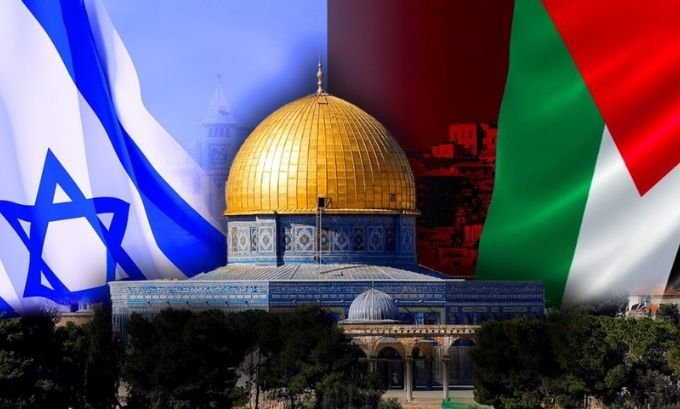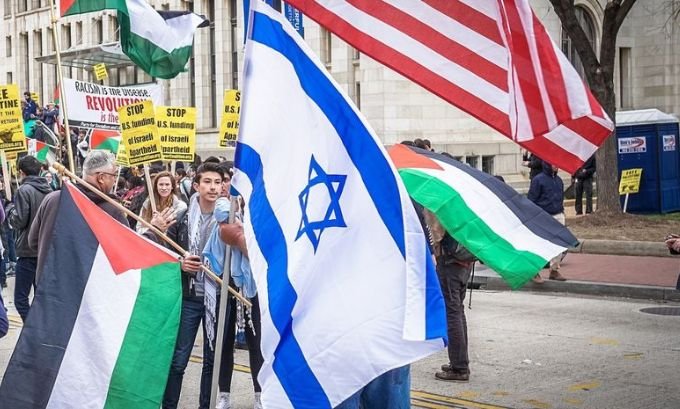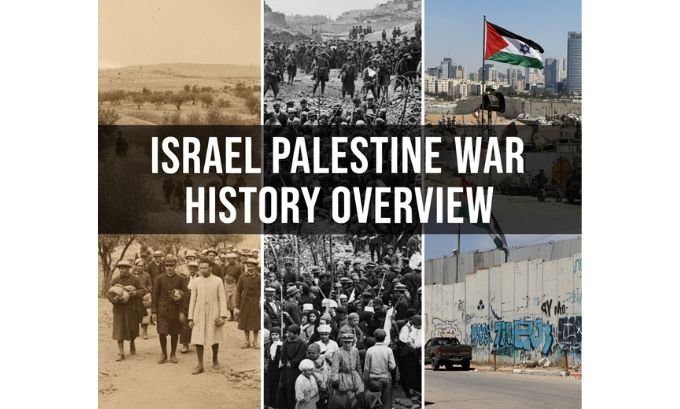The Israel Palestine war history overview is a complex story of faith, territory, and human struggle. At its core is Jerusalem, a city sacred to Jews, Christians, and Muslims, yet fiercely disputed. This article explains the conflict’s roots, key events, and modern implications in simple, factual terms.
Table of Contents
Israel Palestine War History Overview – Origins and Early Conflicts
The Israel-Palestine conflict began in the early 20th century over land, identity, and competing national claims.
The story begins in Palestine, a region under Ottoman rule until World War I. After the war, the United Kingdom took control via the British Mandate. The area had an Arab majority and a Jewish minority. Rising Jewish immigration, driven by persecution in Europe and the Holocaust, intensified tensions with local Arabs.
Key Historical Points:
- The Balfour Declaration (1917): British promise to establish a Jewish homeland in Palestine while protecting Palestinian Arabs’ rights.
- Zionist Movement & Theodor Herzl: Advocated for Jewish migration to Palestine, leading to growing settlements.
- Interwar Period: Violence escalated between Jewish immigrants and Palestinian Arabs.
Experience: Families in Jerusalem and the West Bank experienced early displacement, showing how land disputes directly affected daily life.
Creation of Israel and the 1948 Arab-Israeli War
Israel was declared a state in 1948, sparking war with neighboring Arab nations.
On May 14, 1948, Jewish leaders declared the independence of Israel. Arab nations opposed it, leading to the first Arab-Israeli war. Israel survived, expanded territory, and about 750,000 Palestinians fled or were expelled, an event known as the Nakba (Catastrophe).
Strengths:
- Israel established a functioning state despite initial attacks.
- Jewish diaspora felt a sense of return and security.
Areas for Improvement:
- Palestinian displacement created long-term refugee crises.
- Early borders were contentious and partially unresolved.
| Event | Year | Outcome |
| UN Partition Plan | 1947 | Proposed separate Jewish & Arab states; Jerusalem as international city |
| Israel Independence | 1948 | Declaration of statehood; Arab nations attacked |
| Nakba | 1948 | Mass displacement of Palestinians |
Key Wars and Occupations
Israel and its neighbors fought multiple wars reshaping the region.

Six-Day War (1967)
- Israel captured East Jerusalem, Gaza Strip, West Bank, Golan Heights, and Sinai Peninsula.
- About 1 million Palestinians came under Israeli control.
Yom Kippur War (1973)
- Egypt and Syria launched attacks; Israel defended its territories.
Experience Example: Residents of Gaza Strip and West Bank faced curfews, travel restrictions, and military presence, illustrating the human cost of territorial disputes.
Strengths:
- Israel secured defensive borders.
- Military strategies demonstrated high organization and planning.
Areas for Improvement:
- Occupation created long-term friction with Palestinians.
- Settlement expansion in the West Bank remains controversial.
Religious Sites and Jerusalem’s Role
Jerusalem is sacred and central to conflict due to its holy sites.
- Al-Aqsa Mosque: Islam’s third holiest site; a flashpoint in modern conflicts.
- Temple Mount / Western Wall: Sacred to Jews; symbol of identity and faith.
Why it matters: The overlapping claims of Israel and Palestine on Jerusalem make compromise challenging. Religious significance intensifies emotions and fuels disputes.
Modern Conflict – Hamas, Gaza, and Security Issues
Hamas governs Gaza and frequently clashes with Israel, causing humanitarian crises.
- Gaza Strip: Densely populated; controlled by Hamas since 2007.
- Blockade and Conflicts: Israel and Egypt restrict goods and movement; rockets and airstrikes affect civilians.
- West Bank: Israeli settlements coexist with Palestinian communities under partial Palestinian Authority control.
Strengths:
- Israel maintains security via advanced systems like Iron Dome.
- Hamas is seen by some Palestinians as a protector.
Areas for Improvement:
- High civilian casualties and humanitarian crises in Gaza.
- Political stalemate prevents lasting peace.

Peace Efforts and the Two-State Solution
International efforts aim to establish Israel and Palestine as separate states.
- Oslo Accords (1993): Framework for peace, partial autonomy for Palestinians.
- Two-State Solution: Proposes Palestine in West Bank and Gaza Strip, Israel alongside, with East Jerusalem as Palestinian capital.
United Nations (UN): Mediates disputes, recognizes Palestinian Permanent Observer State, and monitors settlements.
Strengths: Offers internationally supported framework for peace.
Areas for Improvement: Requires mutual recognition and political compromise, often stalled by ongoing violence.
India’s Balanced Stance
India maintains ties with Israel while supporting Palestinian rights.
- Recognizes PLO since 1980.
- Provides aid to Palestinian territories in education, health, and infrastructure.
- Strong defense and technology cooperation with Israel.
Experience Example: Indian NGOs operating in Gaza Strip and West Bank provide humanitarian relief, demonstrating a neutral approach.
FAQs – Israel Palestine War History Overview
1. Why is Jerusalem central to the conflict?
Jerusalem hosts holy sites for Jews, Muslims, and Christians, making it a symbolic and political focal point.
2. What is the Nakba?
The Nakba (1948) refers to the mass displacement of Palestinians during Israel’s independence.
3. What territories are disputed today?
Gaza Strip, West Bank, and East Jerusalem remain contested, with differing governance and settlement issues.
4. Who is Hamas?
Hamas is a Palestinian political-military organization governing Gaza, involved in armed conflict with Israel.
5. What is the Two-State Solution?
A proposed framework establishing Israel and Palestine as independent states, aiming for lasting peace.
6. Has the UN intervened?
Yes, through resolutions, peacekeeping, and recognition of Palestinian observer status.
7. What are major peace agreements?
Notably, the Oslo Accords (1993) laid groundwork for negotiation, though implementation remains incomplete.
Conclusion
The Israel Palestine war history overview is a story of faith, displacement, wars, and peace efforts. Jerusalem embodies the struggle, while Gaza Strip and West Bank illustrate the human consequences. Peace requires understanding both Israel and Palestine, respecting religious sites, and supporting frameworks like the Two-State Solution. Real change begins when global and local actors prioritize dialogue over conflict.
For a broader perspective on how global communities engage with humanitarian causes, check out Tokyo Mart global outreach initiatives
References:
- United Nations Reports on Palestine and Israel
- BBC News – Israel-Palestine Conflict Timeline
- The New York Times – Gaza Strip Humanitarian Reports
- Encyclopaedia Britannica – History of Israel and Palestine
- Oslo Accords Documentation (1993)


